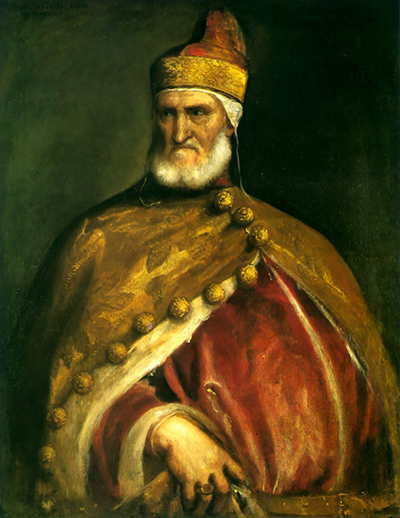The portrait of Doge Andrea Gritti was painted after his death and is likely to have been commissioned by his family as a memorial around 1546, and now resides in the National Gallery of Art in Washington in the US
The doge, or duke of Venice, was a high ranking position and the portrait demonstrates how Titian had become sought after at this stage in his career by the courts and nobility of Europe as well as many other affluent secular figures. Gritti was a particularly forceful figure and acted as doge between 1523-1548, and Titian has very effectively captured this strength and determination which are evident in his portrayal of Gritti's features as he glances sternly to one side.
As with many of Titian's artwork featuring nobility, religious or military leaders, he perfectly represents the ceremonial dress of Andrea Gritti which includes the sumptuous brocade robe and the conical hat which formed part of a doge's attire. The figure comes across as rather austere, commanding and in control and he appears to be about to address an audience or stride forward giving a sense of energy to the image. Titian has enlarged his portrait to fill the canvas which is technique to bring our attention to the importance of the subject and is typical of a new style of portraiture that became prevalent in Renaissance Italy.
Like many of his contemporaries during this era of Italian art, the portrait demonstrates the later Renaissance style of Mannerism, which is characterised by unusual perspectives and distortions of scale in addition to the use of bright colours. The brush strokes Titian uses in this image are an example of his more mature style, and on close inspection they reveal some of his process of creating differing textures of paint in the colour of the robe, the gold buttons and the white fur.
Although Titian dealt with eclectic themes and subject matter he was an excellent portrait painter from an early age and was renowned for the depth of expression and his depiction of the traits of an individual as he somehow managed to capture their essence. In terms of his portraiture, Titian has been likened to both Velázquez and Rembrandt for the clarity and detail of his likenesses.
This commanding portrait encapsulates the character and eminence of his subject, Doge Andrea Gritti, to perfection and is also a reminder of the huge respect and demand for Titian's work and the very high esteem he was held in throughout Europe and beyond. As a comparison of his success and elevated status at the time of the portrait, it is interesting to note that he was equalled only by masters such as Michelangelo and Raphael at this stage in his career.




